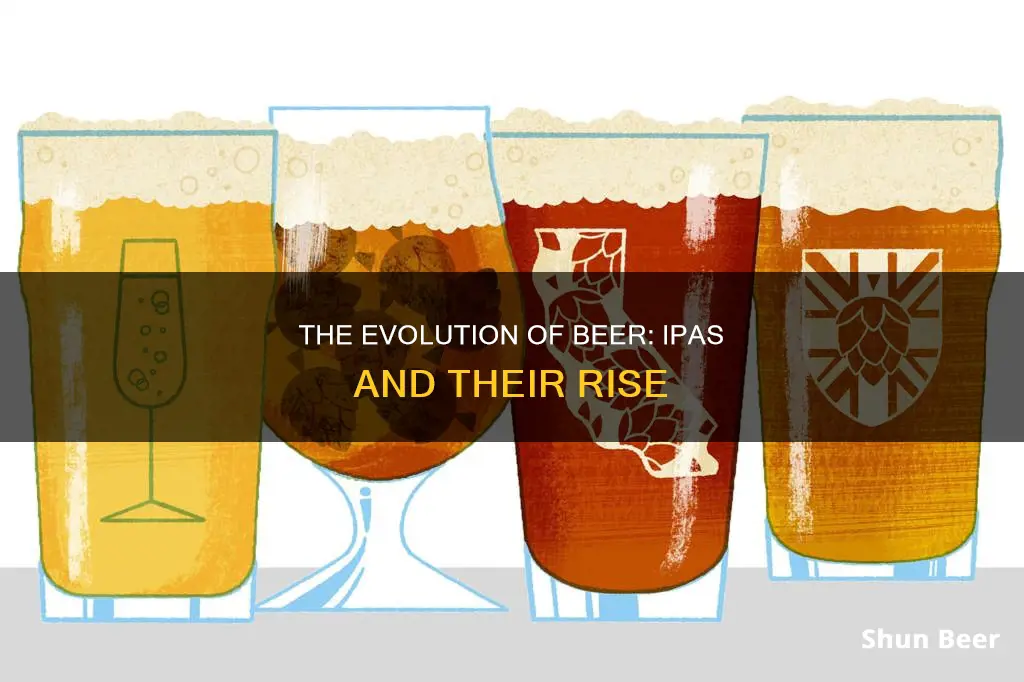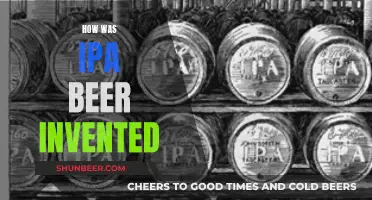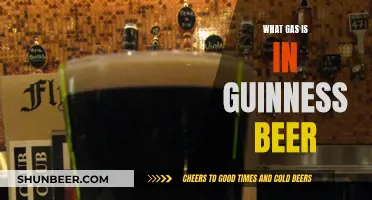
India Pale Ale (IPA) is a hoppy beer style within the broader category of pale ales. The name dates back to the British Empire and its colonies, specifically the sailors who were looking for a beer recipe that would be easy to preserve on long trips from Britain to India. The weather in India was too hot and humid to brew beer, so the sailors brewed a beer with lots of hops that could survive long journeys without going bad. The first recorded instance of an IPA being used to describe a beer was in an 1829 advertisement in the Sydney Gazette and New South Wales Advertiser.
| Characteristics | Values |
|---|---|
| Name | India Pale Ale (IPA) |
| Origin | British colonial times |
| Purpose | Preservation on long trips from Britain to India |
| Flavour | Hoppy, fruity, bitter, malty, piney, citrusy, floral, earthy |
| Alcohol Content | 4-7% or more |
| Types | Session, Double/Imperial, Dry-Hopped, Triple Dry-Hopped, Single-Hopped, Fresh-Hopped, New England, West Coast, East Coast, British, Oat, Lactose/Milkshake, Belgian, Fruited, Sour, Brett, Hazy, Unfiltered, Black, Brut, Double/Imperial, New England, Triple, American, West Coast, White, India Pale Lager/Cold |
| IBU | 40-60 (average), 50 (most common) |
| Calories | 170-240 per serving |
| Carbohydrates | 30 per serving |
What You'll Learn
- IPA stands for Indian Pale Ale or India Pale Ale
- IPAs were created by British sailors to withstand long journeys from Britain to India
- IPAs are known for their hoppy aromas and flavours
- There are many types of IPAs, including New England, West Coast, Session, and British styles
- IPAs are best consumed within the first few weeks of production

IPA stands for Indian Pale Ale or India Pale Ale
India Pale Ale, or IPA, is a hoppy beer style within the broader category of pale ales. The name comes from the beer's history as an export beer shipped to India, which was under the control of the British East India Company until 1858.
The pale ales of the early 18th century were lightly hopped and quite different from today's pale ales. By the mid-18th century, pale ale was brewed mostly with coke-fired malt, which produced less smoking and roasting of barley in the malting process, resulting in a paler beer. One such variety was October beer, a pale and well-hopped brew popular among the landed gentry, which was intended to be cellared for two years.
Among the first brewers known to export beer to India was George Hodgson's Bow Brewery, on the Middlesex-Essex boundary. Its beers became popular among East India Company traders in the late 18th century due to its proximity to the East India Docks and its liberal credit line of 18 months. Ships exported this beer to India, and it benefited exceptionally from the conditions of the voyage, becoming highly regarded among its consumers in India.
Early IPAs were only slightly higher in alcohol than other beers brewed at the time, but more of the wort was fermented, resulting in fewer residual sugars, and they were heavily hopped. While IPAs were formulated to survive long voyages by sea, porter was also successfully shipped to India and California.
By the 1860s, India Pale Ales were widely brewed in England and were much more attenuated and hopped than porters and ales. Demand for the export style of pale ale, which became known as "India pale ale", developed in England around 1840, and IPA became a popular product in the country.
In modern times, there are many different styles of IPAs, including Session IPAs, Double/Imperial IPAs, Dry-Hopped IPAs, New England IPAs, and more. IPAs are known for their bitter quality due to the higher-than-average amount of hops they contain, but they can also have fruit and citrus notes.
Guinness Beer: The Mystery of the Plastic Ball
You may want to see also

IPAs were created by British sailors to withstand long journeys from Britain to India
India Pale Ale, or IPA, is a hoppy beer style within the broader category of pale ale. The name comes from the beer's origins in Britain, where it was first created for export to India.
IPAs were created in the early 1800s, with George Hodgson's Bow Brewery often credited as the first brewer of the style. However, British troops in Asia drank porter in India throughout the 19th century, and most of the pale ales exported to India were consumed by the middle and upper classes among the expats. The IPAs of the time were not particularly strong, and any beer exported to warmer climates was highly hopped to protect it from spoilage.
The IPA was developed to withstand the long journey from Britain to India, as well as the changing temperatures and hot, humid climate of India. Hops were used as a preservative, and their distinct aroma and flavour became characteristic of the style. Brewers also brewed the beer with a higher ABV than usual to prevent infection and maintain its flavour during the journey.
The first IPAs were only slightly higher in alcohol than other beers of the time, but more of the wort was fermented, resulting in fewer residual sugars. They were also heavily hopped, which, in addition to preserving the beer, created a bitter-tasting beverage.
The style became popular in England around 1840, and by the 1860s, India Pale Ales were widely brewed in the country.
The Harp: Guinness Beer's Musical Label Identity
You may want to see also

IPAs are known for their hoppy aromas and flavours
IPAs, or India Pale Ales, are known for their hoppy aromas and flavours. The use of hops in IPAs dates back to British sailors on long voyages to India during the colonial era. The hops acted as a preservative, allowing the beer to survive the months-long journey. While early IPAs were characterised by their bitter taste, modern IPAs explore a range of fruity flavours that can be derived from hops.
The hops used in IPAs are the pinecone-like buds of humulus lupulus, a fast-growing climbing plant. There are dozens of distinct hop varieties, each with its own unique flavour and aroma. Brewers can select different strains of hops to create IPAs with flavours ranging from lemon and grapefruit to grass, wood, pineapple, and even onion and cheese.
The level of bitterness in an IPA can be measured by its IBU (International Bittering Units) ranking. The IBU measures the acid content in hops, and the higher the IBU, the more bitter the IPA. Most IPAs fall between 40 and 60 IBUs, but some may go higher or lower depending on the variety of hops used and the brewing techniques employed.
One technique that enhances the hoppy character of IPAs is dry-hopping, where hops are steeped in fermenting beer instead of being added during the boiling process. This amplifies the fruity, piney, or candy-sweet notes of the hops without adding bitterness. Modern IPAs may also utilise double or triple dry-hopping, where a fresh batch of hops is added halfway through the process, to further intensify the hoppy aromas and flavours.
In addition to the type of hops and brewing techniques, the region where the IPA is crafted can also influence its hoppy profile. For example, American IPAs tend to emphasise citrus and tropical fruit notes, while British IPAs are known for their maltiness and more bitter flavour.
Vegan Alert: Guinness Beer's Surprising Ingredient
You may want to see also

There are many types of IPAs, including New England, West Coast, Session, and British styles
India Pale Ale (IPA) is a hoppy beer style within the broader category of pale ale. The IPA is characterised by its use of hops, which add bitterness and aroma to the beer, balancing out the sweetness from the malt. Hops are the star of the show in an IPA, giving the beer its characteristic bitter taste and often contributing to a fruity or floral aroma.
There are several types of IPAs, each with its own unique characteristics. These include:
New England IPA
Also known as a Hazy IPA or an East Coast IPA, this style of IPA is unfiltered, giving it a hazy appearance, and has extremely low bitterness due to the use of blends of hops that lend an intense, fruity flavour. New England IPAs are often dry-hopped and tend to be fermented to have lower carbonation. They typically have an ABV of around 5%.
West Coast IPA
This style of IPA is known for its strong hop flavour and high bitterness. West Coast IPAs often use American varieties of hops such as Citra, Chinook, or Cascade, and are notoriously bitter and citrusy with fantastic earthiness and piney aromas. They usually have an ABV between 9% and 13%.
Session IPA
Session IPAs are lighter in alcohol content, typically with an ABV of less than 5%, but still packed with hop flavour. They are lighter in body compared to traditional IPAs, making them easy to drink, but they are also heavier and more sluggish due to their higher carb and calorie content.
British IPA
British IPAs, also known as English IPAs, are traditionally more balanced between malt and hops, with earthy and floral flavours. They use exclusively English varieties of hops and are usually grassy and earthy with a hint of citrus. They have a very dry finish and an ABV between 6% and 7%.
Does IPA Beer Contain Fat?
You may want to see also

IPAs are best consumed within the first few weeks of production
India Pale Ale, or IPA, is a hoppy beer style within the broader category of pale ale. The name comes from the fact that it was originally an export beer shipped to India, which was under the control of the British East India Company until 1858.
The faster an IPA is consumed after production, the better. While some sources suggest that an IPA should be consumed within three weeks of production for the best flavour, others state that an IPA can retain its flavour for up to three months. However, it is recommended to avoid buying an IPA older than three months.
To ensure the freshest IPA, it is best to buy from a store devoted primarily to beer, as these stores tend to push out bottles at a faster rate. Additionally, it is important to pick an IPA that has stayed cold throughout its time on the shelf, as cold temperatures slow degradation.
Understanding Beer Expiry Dates: A Guide for Guinness Lovers
You may want to see also
Frequently asked questions
IPA stands for Indian Pale Ale or India Pale Ale.
The IPA was invented in Britain during the colonial era. British sailors needed a beer that would stay good during their long voyages from Britain to India. They found that adding lots of hops to the beer preserved it and stopped it from going bad.
An IPA is hoppier and bolder than a pale ale. If a pale ale is Tabasco sauce, an IPA is a habanero hot sauce.







